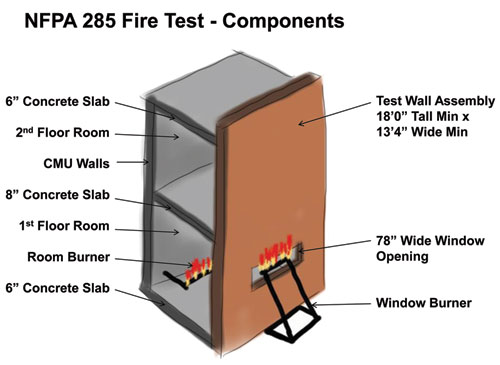Navigating Wall Assembly Fire Testing
 |
|
This diagram shows the testing structure for NFPA 285. Image courtesy of DuPont Building Innovations |
Some of the thermocouples are placed on the exterior wall surface, while others are positioned in the wall cavity air space or insulation, or both. Additional thermocouples are positioned in the insulation or the stud cavity, or both. As for the test specimen itself, the minimum height is 18 feet and the minimum width runs 13 feet, 4 inches.
| IBC Construction Categories |
The International Building Code divides construction materials into five types as follows:
|
Combustible Components In A Noncombustible Wall Assembly
While noncombustible cladding—including brick, masonry, stone, terra cotta, concrete, cementitious stucco, fiber cement boards and panels—do not alone trigger NFPA 285 testing, they are generally heavier, more expensive materials.
Taking a closer look at combustible cladding types, MCM cladding systems are available in open and closed joint systems and run between 3 millimeters and 25 millimeters in panel thickness. Factory bonded with a metal face and plastic core, the full system is made up of joints, a substructure, and an attachment mechanism. Because different manufacturers utilize different core materials, it's important to note that fire performance characteristics will vary. And even if the product looks the same as an NFPA 285-tested MCM and bears a similar product name, if a different core material is utilized, that specific product requires a separate NFPA 285 test within the wall assembly configuration.
Using MCM below 40 feet, while not triggering an NFPA 285 test, is limited to 10 percent of the wall area when the building separation is less than 5 feet. MCM cladding use above 40 feet, but below 75 feet, may not require an NFPA 285 assembly test, depending on a complex assessment of: installation area, panel sizes, horizontal and vertical separations, presence of a whole-building sprinkler system, building separation distance, and whether the cladding self-ignites below 650°F, per ASTM D1929.
EIFS systems are regulated by the IBC under foam plastic requirements, and must meet ASTM E2568, which includes, but is not limited to, accelerated weathering, freeze/thaw, salt spray resistance, tensile bond adhesion, water penetration, and resistance testing.









